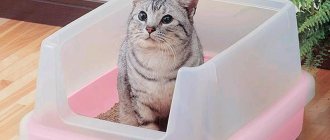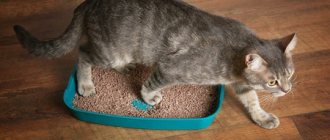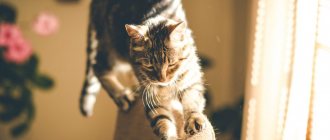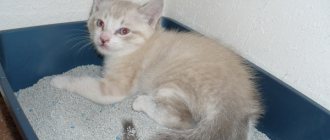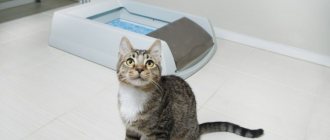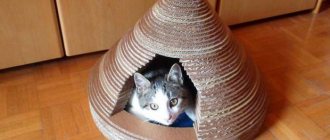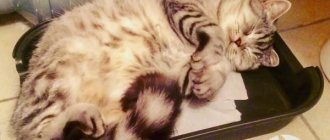Mother teaches kitten
The first thing you should know: you cannot take a very small kitten from a cat, that is, younger than 1.5 months. Many large nurseries that care about the health and behavior of animals give away kittens after three months.
The fact is that in addition to feeding milk, a mother cat sets an example for her cubs on how to eat, how to hunt and protect themselves. But the most important thing for the owner is that the adult cat shows the cubs where to go to the toilet. This is why it can be difficult to immediately train a one-month-old kitten to the right place.
conclusions
If the proposed methods do not help, then the cat should be limited in its freedom of foresight around the apartment, leaving it a small area where the tray will stand. Everyone knows that cats are clean creatures, so after a while your pet will understand what the tray is for, and the problem will be solved. There are cases when a cat that has already been trained to use the litter box suddenly begins to relieve itself in the wrong places. There is no point in scolding and beating her for this. You just need to reconsider your relationship with her or contact a veterinarian. The cat may simply lack attention, or such chaotic bowel movements may be a symptom of some disease. These very simple recommendations can help you cope with the problem of “cat litter”. You just need to be persistent and patient at this time. Then your pet will learn to be well-mannered, and in return you will receive a lot of pleasure and joy when communicating with him.
Video
Bringing the kitten home
When the cub is separated from its mother and begins to live independently, it is taken to a new home.
Before you bring a kitten, you should first prepare everything:
- Buy a tray.
- Select and purchase filler.
- Buy a scoop for cleaning the tray.
- Choose a place for the toilet.
As soon as you bring the kitten into the house, place it in the litter box. To create the smell, you can take a napkin from the house where the kitten used to live, which was lying in the mother’s tray.
Show the kitten his toilet and let him get comfortable. The litter box must be in a secluded place so that the kitten feels comfortable and can do what he needs in silence and without distractions.
The next stage is to let the kitten get comfortable in the space. At the same time, he should not be frightened: nervous animals often have problems with training and adaptation. If the kitten gets scared, it may stop going to the litter box and it will be difficult to force it. The question of why a kitten doesn’t go to the toilet arises quite often, especially in the first months of its life in a new apartment.
In order for him to stop going to a place not intended for these purposes, you will have to make a little effort. In many ways, everything depends on the character of the pet and its intelligence, but occasionally there are cats that mark their territory. Usually this problem arises with the onset of puberty and there are other methods of solving it.
Perhaps the animal will learn on its own, but the owner will still have to help him and let him understand how to do it correctly.
How to train a kitten to use a litter box
When teaching a kitten good manners, you should pay attention to the choice of tray, filler, and also the place where the tray will be located.
Tray
You should start by choosing a tray; it can be of any shape, but the size should be large (i.e., just like for an adult cat). Material: durable, non-electrifying plastic. It is also important that it is comfortable for the pet, cleans well and does not absorb odors. The presence or absence of a plastic grill is unimportant. It is recommended to use a tray with a protective rim, which helps reduce spillage of the filler. Open trays vary in the height of the sides, as well as the presence or absence of a mesh.
Cats are naturally shy, so it is preferable if the litter box model is closed. Alternatively, a toilet house may be suitable. A closed tray creates a feeling of privacy, but is less easy to handle.
Closed tray
In addition, if the cat gets fat when it grows up or is initially a large breed (for example, Maine Coon), it may be inconvenient for him to use such a toilet; he simply will not fit in it.
Closed toilet-house
You need to buy a tray in advance, before your pet arrives at the apartment. Additional accessories you will need are a rubber mat to prevent the filler from spreading around the room, and a spatula for cleaning.
Filler
Modern fillers are:
- mineral (based on bentonite clay);
- woody;
- corn;
- silica gel;
- paper
Most of them have a color indicator. Many breeders prefer odorless clumping ones (you should ask your pet store).
Suitable fillers must have good hygroscopicity (effectively absorb moisture) and not leave dust. The best are silica gel and wood. In addition to high moisture absorption, they also eliminate unpleasant odors. Options based on grain and paper waste are also suitable. Keep in mind that cats do not like toilets treated with deodorant.
Sometimes small cats begin to eat the litter. At the same time, the silica gel version has a significant drawback; if it enters a pet’s esophagus, it can cause poisoning. To prevent this from happening, it is advisable to purchase a corn analogue. It is harmless, however, relatively expensive. It is possible that if a cat eats litter, it lacks microelements or vitamins - an additional consultation with a veterinarian will not be superfluous. As a final precaution, a fine mesh screen should be used.
For a small pet, chipboard pallets are an ideal option. They are not dangerous to the baby's health, absorb moisture well and absorb odors, in addition, the dirty contents of the tray can simply be flushed down the toilet.
From the author . We buy wood litter for our cat. It doesn’t smell at all, unless, of course, you clean up after the cat in a timely manner, and not after three days)). Moreover, it is the cheapest. For example, the last time we ordered on Ozone, for 500 rubles. bought 25 kg. This amount lasts us for 6-9 months, depending on how we use it, but we manage it quite economically. You can also train your cat to use the toilet; special devices are even sold for this. Read, we wrote an article about this.
Place
The cat litter box should be located away from where the kitten eats, and at first, strictly in sight of the fluffy one. It should be easy for a small cat to get to the litter box. In order not to disorient the baby, it is better not to rearrange the latrine. A toilet on the balcony is the optimal place if it is glazed and connected to the room by a door and a window.
It is important to monitor shoes, which can provoke your pet to take hasty and thoughtless steps.
Methods for training a kitten to use the tray
Education should begin with getting to know the place. A small cat should be placed in a container and given the opportunity to sniff. Then apply a drop of water to the paw, thus allowing the animal to feel the purpose of this place at the subconscious level.
For the same purposes, you can carefully dig into the filler with your paw or scrape it with your finger. In the first 2-3 days, it is advisable to limit the baby’s movement outside the kitchen or one of the rooms. In this case, it is better to remove the carpets.
It is necessary to observe the kitten at first. The pet may begin to squeak, act as if it is looking for something, look around and sniff, sit down and scratch objects. Growing up, animals can move with their tail raised or jump sideways.
If signs of anxiety suddenly appear, you should transfer the animal to the tray, not giving him the opportunity to get out until he does the job. At the same time, it is important not to scare the baby, not to raise your voice, and not to allow actions that could cause fear in him.
It is recommended to drop off your pet after sleep and approximately 20-40 minutes after eating. One of the surest signs that a kitten needs to do important things is its unexpected immobility and alertness.
If the kitten has done everything correctly, it should be praised, petted and, perhaps, treated to something tasty so that the pet has the most pleasant memories and the correct reflexes are formed.
It is better not to immediately remove the used filler at first. A small cat must remember the right place by smell.
If suddenly, after a few days, an unpleasant surprise appears in another place, you can lightly scold the cat. For educational purposes, lightly tap the nose with your finger. In this way, cats point out to kittens their mistakes. It is recommended to transfer the results of his pranks to a tray into which the kitten should be transferred. The place where the baby went should be disinfected (otherwise he will continue to go to this place).
Important! If the pet’s prank was discovered an hour or more ago, any attempt to conduct an educational conversation will cause misunderstanding on the part of the kitten. He is unlikely to remember where and when he could upset his owner.
If the animal cannot be trained, you should change the place and/or filler, and also pay attention to the surrounding odors. Cats do not like the smell of citrus fruits and other strong aromas. It happens that the kitten begins to go where children used to go (bedspreads, sheets), guided by the smell. In this case, so that the cat is not disoriented by materials marked in this way, they should be disinfected.
Automatic robot toilet
If suddenly an animal for some reason relieves itself in a strictly defined place that suits the owners, you can safely put a tray there and put an end to the learning process. If consensus between the person and the kitten is not reached, it is recommended to move the latrine daily in the desired direction by about 10 cm.
In cases where the kitten misses, you should try to find out the reasons for this failure. These include:
- poor orientation of the animal in space due to its young age;
- unpleasant odor of the litter or tray;
- high sides of the tray for a kitten;
- filler that is undesirable for some reason for the animal.
In order for your efforts to be crowned with success, it is useful to remember a few simple rules:
- When picking up your pet from the breeder, it doesn't hurt to grab litter from an old litter box (as a hint).
- It is recommended to buy a special spray for the tray. Processing the filler in the tray will make the animal want to use the container for its intended purpose.
- It is better to place the tray in a secluded place: on the balcony, bathroom or toilet.
- In pet stores, it is advisable to purchase aerosols that will wean animals from “shitting” in places undesirable for their owners.
- An ammonia solution, table vinegar, or commercially available special products can neutralize the unpleasant odor of cat feces.
- To protect pots with indoor flowers, the top layer of soil should be covered with small decorative pebbles or orange or lemon peels. Cats don't like them.
- The litter box must be kept clean, which all cats love.
- If the area of the room is significant, it makes sense to accustom the animal to 2-3 trays at once, located at a distance from each other. In cases where there are 2 cats in the apartment, you should provide a tray for each of them, and put another common one, a spare one. It is extremely rare for pets to prefer one tray for small activities, and another for large activities.
- The frequency of changing the filler should be at least once every 3-4 days (for clumping ones). It is recommended to remove the used substrate 1-2 times a day, adding a new one in its place.
- It is better to pour wood chips in small quantities and throw them away daily, and disinfect the tray.
- It is more logical to feed your pet by the hour. This will allow you to control his behavior, identifying unwanted latrines.
- The transition to a new filler should be done gradually.
- If the pet constantly misses, after thoroughly cleaning the area of misbehavior, a bowl of food should be placed there. His instincts will force him to behave correctly.
- To attract the animal, add a few drops of lavender oil or catnip to the litter.
At one month of age, small cats and cats become capable of perceiving information. For training a kitten up to 2-3 months of age. It will take approximately 2-3 weeks. It will take a three-month-old cat 1-2 weeks to master science. Animals are easiest to learn when they are 3-6 months old, but it’s rare that an owner can tolerate problems with their cat’s litter box for six months.
Starting from 6 months. It is more difficult for an animal to assimilate new things, since by this time a behavior pattern has been formed.
According to a number of breeders, training a pet should begin as early as possible, because if a cat has formed habits that are harmful to the owner before 3 months, it will be quite difficult to wean him off them, and after 6 months. - almost impossible. All attempts at re-education will most likely be futile.
Toilet training process
The little kitten goes to the toilet quite often and can't stand it. The owner will have to learn to determine when he wants to do his business. As soon as the baby begins to squat, he should be calmly transferred to the tray. If suddenly the kitten manages to make a puddle, it should be wiped with a strong odor-repellent agent.
A cat litter box without litter and with one mesh is, of course, convenient for the owner, it is easier to clean and no money is spent on it, however, it can be difficult to immediately accustom a kitten to the litter box for the reason that the cub does not understand what they want from him.
Under natural conditions, animals relieve themselves on the ground or in the sand, and then bury them. You can imitate natural conditions if you use bulk filler. The kitten will be happy to dig into it and this will help make it stop going to the toilet in other places.
Additionally, when the process of accustoming to a place occurs, you can use a special spray. Please note that there are two types of training aids:
- Repellent. They have a strong aroma and mask the smell in the place where the kitten went.
- Attractive. This spray is sprayed directly into the cat's litter box so that habituation in the apartment takes place as quickly as possible.
Usually, training a kitten to use a litter tray is not difficult. Cats are clean animals and get used to going to one place, but for the pet to get used to it quickly, this place must be comfortable.
Selecting a location
The owner wants to immediately put the cat’s litter box in the “right” corner, so that it is not in plain sight. However, owner and pet preferences may differ.
Basic requirements for choosing a location:
- A secluded and quiet corner is needed. Loud noises frighten both small and adult cats.
- The animal should always have access to it.
When potty training an adult cat, place it in a secluded place. A kitten who lived with the breeder in the same room with its mother may get confused in a large apartment and forget where the toilet was assigned to it.
It is better to allocate a personal corner for the baby and place the tray not far from the sleeping place so that the little one has time to run. When the pet gets used to it, the container can be moved to the bathroom or any other room, but with constant access. This means either keeping the door open or making a small cat door in it.
If you bought a quality product, but your baby ignores it, it’s probably the place that he doesn’t like. An option is to buy several inexpensive pallets and place them around the house. Observe which one your pet prefers. Remove the rest, and gradually move the one you like to the desired part of the apartment.
Training errors
If your kitten does not go to the toilet, this may happen for the following reasons:
- The tray is not convenient enough.
- The animal was scared in the place where the tray was installed.
- The kitten was taken too early, and the mother cat did not have time to teach her to go to the litter box on her own.
- The animal has health problems, so it does not have time to reach the place.
If a kitten does not go to the toilet, this problem must be corrected as quickly as possible: the main character traits are formed in childhood, and it will be more difficult to retrain later. The owner must be persistent, but at the same time gentle, so as not to scare the small pet.
Hygiene needs to be paid attention from the very first days of the animal’s appearance in the apartment. The spray is an excellent tool if you need to wean off marks and change your pet's behavior when the kitten does not go to the toilet.
Tray selection
In many ways, how quickly you can accustom a cat to the litter box depends on the design of the litter box. The most important thing is that it fits in size and is comfortable. It is worth considering that a tray that is too small and light will turn over.
There are 3 common varieties:
- With mesh and low sides. If the breeder has trained the kitten to do without litter, then choose a tray with a grid. Advantages of the design: convenient, easy to care for, saving on filler. However, the smell of urine does not disappear. While the kitten is small, there is no need to worry. Until one year of age, urine has virtually no odor. But over time, the plastic becomes saturated with this smell.
- With high sides without bars. Involves the use of filler. It is believed that this design is more suitable for adult animals. It will be difficult for a kitten to get over sides that are too high. Therefore, the best option is a toilet with a filler with medium-high sides, slightly curved inward. When actively buried, the granules will not fly away in different directions. In addition, cats will be able to exercise their instincts to bury feces.
- Closed house (with filler). The good thing is that the granules don’t spill out onto the floor. However, some pets are afraid of this design.
In addition to purchased ones, a toilet can be any device with a recess, which is easy to make at home. The main thing to remember is that cats don't like their paws getting wet. There is also no need to use metal pallets and cardboard boxes. The bottom of metal products oxidizes from urine, paper products become soaked.
Which filler to take
Modern manufacturers make many types of fillers from natural and artificial materials that absorb moisture well and eliminate odors.
Manufacturers of cat litter have developed many interesting models.
Of course, in order to save money, you can buy regular sand at a hardware store, but it will remain on the kitten’s paws and spread throughout the apartment, and it will not get rid of the unpleasant smell of cat feces.
What types of filler are there:
- Clumping filler is made from fine bentonite clay, which forms a lump when interacting with moisture. It is easy to remove and economical to use.
- Absorbent fillers are made from clay, which is processed by drying, pressing and granulation. The downside of clay is that it sticks to the animal's paws. The kitten will try to clean it from its paws, so there is a possibility of swallowing it and subsequent poisoning of the animal.
- Pressed wood is made from sawdust from coniferous trees. This option is the most environmentally friendly and will not harm the kitten. The disadvantage of wood filler is that it disintegrates when exposed to moisture and is difficult to remove from the tray.
- Silico-helium composition is the most economical option, although its cost is higher than others. It eliminates odor well and quickly absorbs moisture. It is produced on the basis of silicic acid hydrosols. The balls made from them do not change their structure and do not crumble when feces enter them. Silica gel changes color, thereby allowing you to determine when it is time to change it.
- Natural materials (cellulose, grain) are an environmentally friendly and cheap option; they hardly stick to the kitten’s paws.
- Mineral compositions are made from processed volcanic minerals; such granules quickly absorb moisture and odors for a long time.
Advice! For adult animals, any type of filler is suitable, but for small kittens who like to taste everything, it is better to choose a natural one.
Kitten in the house, where to start?
Tray training a kitten begins with three main tasks:
- Selecting the tray itself.
- Choice of filler.
- Choosing a place where the “toilet” will be located.
© shutterstock
Let's consider all these points in detail.
How to choose a tray
The opinion that a small kitten needs a small tray is wrong. These animals grow very quickly.
It will be more practical to immediately take a full-sized container. The stronger the plastic of the product, the better.
Trays can be with or without bars. The grid is placed over the filler and prevents the pet from getting its paws wet. The device is convenient, but there is also a drawback - obeying its instinct to bury feces, the kitten will constantly cling to the plastic grate with its claws and may even damage them. The practice of “cat breeders” shows that it is better not to use mesh , but simply take a good filler that immediately absorbs moisture.
If the cat experiences pain, it will not be possible to accustom him to the cage.
The shape of the container does not matter (there are oval, square, angular), you can accustom it to any. A protective rim, which is placed on top of the tray, will be useful - it will prevent the filler from falling apart when your pet carefully cleans up after itself.
Important! It is necessary to choose a tray for a kitten even before a new family member appears in the house. If the purchase of an animal happened unexpectedly, it is worth purchasing everything you need on the same day.
Trays and what they are eaten with
Identifying cat litter boxes may not be the most necessary skill in life, but it will certainly help you choose the right “potty” for your baby. Taking into account the daily amount of free time for cleaning the toilet and a number of other factors, cat trays are usually divided as follows:
- Low trays with mesh are the most affordable option of all existing ones. However, such a tray must be cleaned at least twice a day.
A low tray will be an excellent solution only for small kittens. It’s convenient to climb into, and it doesn’t look so huge or scary for a small fluffy creature. There is a possibility that an older cat will not like such a tray. The fact is that animals do not feel protected when the walls of the vessel are too low.
- High trays (mesh + filler) are the optimal solution for owners who are often absent from home. A high-quality filler is able to retain odor and absorb moisture so that it lasts for the whole day.
- Tray houses are suitable for large apartments, as they take up quite a lot of space. This tray is more expensive to maintain and needs to be cleaned longer and more thoroughly than a regular one. The walls tend to retain an unpleasant odor, which is not entirely pleasant for members of the cat family. Nevertheless, the interesting and original design of such a tray can become a stylish element of the interior.
If the cat feels comfortable on the tray, then it will return there again and again to the joy of the owner. Thus, taking into account the following recommendations, you will certainly be able to create a comfortable corner for your kitten to fulfill his needs.
- The tray should first of all be practical, that is, it should be easy to clean and wash.
- Size also matters in this case. The dimensions of the vessel must correspond to the parameters of the animal. With age, the tray can and even needs to be changed.
- The optimal number of trays for one cat is two. Cats are extremely clean creatures and will not go to the toilet if they are dirty. It’s wiser to play it safe and buy another litter tray in case you don’t have time to clean up after your pet or are away.
- It is important that access to the tray is always free. Owners often mistakenly place a tray in the toilet room, which they forget to leave ajar. In this case, there is no point in being surprised or nervous when your pet shits right under the door.
- It is preferable to choose the most quiet and secluded place for the toilet. Anticipating popular questions, we immediately provide the answer: “No, a place next to a constantly humming refrigerator or washing machine is not suitable.” Although it may be secluded, the loud noise will certainly frighten the small animal.
